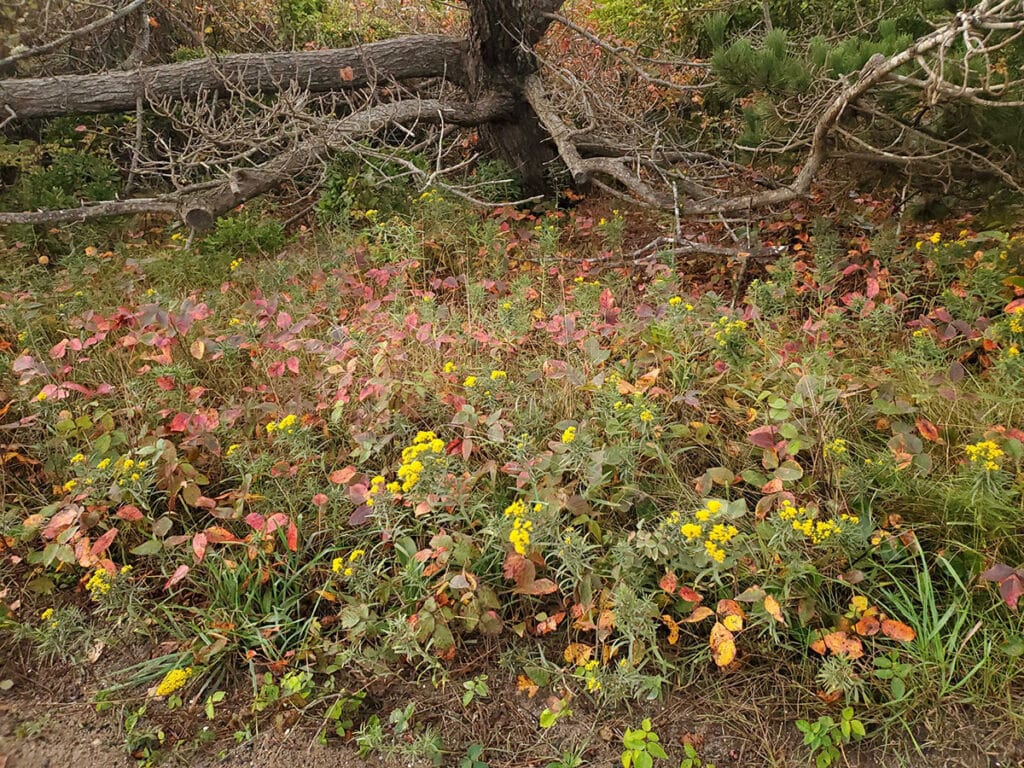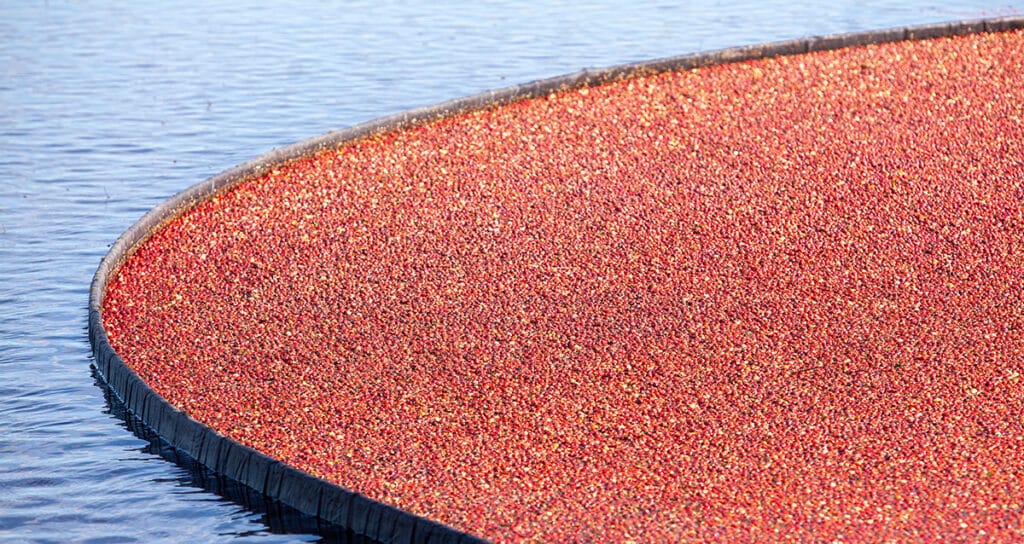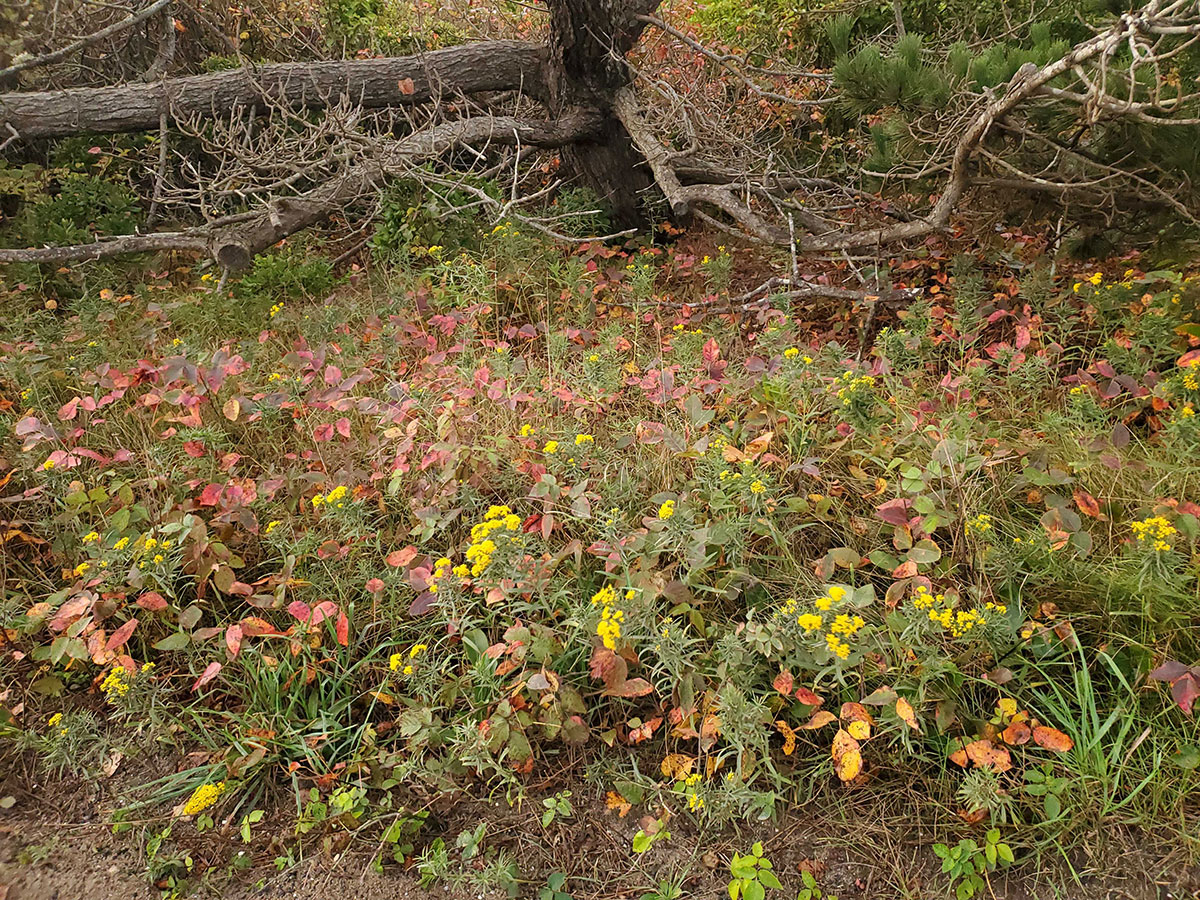by Dr. Sarah Treanor Bois
Director of Research & Education at the Linda Loring Nature Foundation
Fall on Nantucket usually heralds the slowing down of life on-island. Businesses change their hours, restaurants close for a few days every week, and the ferries have reduced schedules. During a typical fall, the rhythm of the island shifts from the manic excitement of summer to school schedules, Friday night football games, and making plans for winter travel.
This year, like everything else, fall is far from typical. There are more people on-island than ever, businesses are staying open longer to salvage the season, and school…well, as a working parent, I won’t even touch that one. But one thing hasn’t changed: nature still moves forward.
There is still a lot of autumn magic on Nantucket. Right now we are in the golden months of fall, when some of the days can still have a summer quality— good enough for boating, biking, fishing, and maybe a swim—while the nights are cool and sleeping is much easier.
If you are new to this time of year on-island, welcome to fall on Nantucket! Here are some ways we can enjoy Nantucket nature this fall.
WILDFLOWERS ABOUND
Fall is the season for asters. Many of our showy asters are blooming now. I’ve written before about the yellow goldenrods (all 15 species of them on-island!) which are excellent nectar sources for migrating monarch butterflies and other pollinators. Goldenrods (Solidago ssp.) can be found all over the island, so almost any trail will do to check out their diversity. Check out all the various plumes and leaves. While they may all look similar, they are uniquely adapted to various habitats and therefore the bog goldenrod can be found mostly in wetlands and on the edges of wetlands, while the seaside goldenrod has tough waxy leaves allowing it to proliferate in the sandy environments near the beach.
Aster blossoms appear “daisy-like” which are called composite flowers. Composite blossoms are actually two types of flowers. Disc flowers form the flower head’s “eye,” while ray flowers look like petals on a simpler flower. Many purple, white, and a few pink species come into bloom now. Late Purple Aster (Symphyotrichum patens) has purple ray flowers and yellow disk flowers. The leaves are rough, clasping the stem like little cat tongues. The Bushy American Aster (Symphyotrichum dumosum), is like a tiny bunch of small, white daisies and is common along the coastal plain. These are just a few examples. Go into any semi-grassy a rea or low shrubs and there will be many more to explore.

FALL COLOR
When we think of “leaf-peeping” as a fall activity, we usually think of slow drives in Vermont or New Hampshire. And while Nantucket may not boast the colors of the northern states, we still host pockets of fall color if you know where to look. The tupelo trees (Nyssa sylvatica) of Squam Swamp, Masquetuck, and others turn a bright red in fall. The American beech trees (Fagus grandifolia) of similar wet habitats can be yellowy-copper in fall.
My two favorite fall colors on Nantucket are not from trees, but vines. The five-leaved Virginia creeper (Parthenocissus quinquefolia) is one of the earliest fall colors turning bright purplish-red before the leaves fall off the vines. Similarly, poison ivy vines (Toxicodendron radicans) turn one of the sharpest shades of red in autumn. Driving up Milestone Road, you’d think the street was lined with red maple trees, but it’s simply the large poison ivy vies growing up and around the pine trees of the State Forest that give the road edge its fall colors.
Other shades of red can be seen in the black huckleberry shrubs that can turn a crimson shade. Non-native invasive species such as burning bush (Euonymus alatus) also turn color, but are generally relegated to private yards or plantings in commercial landscaping.
CRANBERRIES
The Nantucket Conservation Foundation (NCF), unfortunately, had to cancel the popular cranberry festival this year due to restrictions around COVID-19. Even so, there are still many ways to enjoy the cranberries throughout the fall. In October NCF is offering small group cranberry harvest tours. You can sign up your family at nantucketconservation.org. That’s even better than waiting in line for the hay ride.
You can also visit some of the bogs on your own and take in the natural beauty. The Windswept Cranberry bogs off of Polpis Road will be undergoing some major restoration work over the next several years. Go for a walk now around the remnant bogs (which are no longer in production), and check out the changes as they occur in the coming months. Even though most people think of cranberry bogs as agriculture and cranberries as a food product, cranberries (Vaccinium macrocarpon and Vaccinium oxycoccos) are a native part of the Nantucket flora. Naturally, they can be found as part of the biodiversity of bogs, fens, and marshes.
Here is a historical tidbit from a 2015 YI article by Amy Jenness, “Native Americans harvested the tart berries for both culinary and medicinal purposes and may have taught the English settlers how to use them. The wet bogs where cranberries like to grow helped sustain islanders during the American Revolutionary War and the War of 1812, when all trade with Nantucket was prevented by both the British and the Patriots. Islanders were close to starving by the end of both those wars, and Nantucketers harvested what they could from the land and sea and kept themselves warm by burning peat from the bogs.”
The NCF website also has lots of cranberry fun facts and videos from harvests over the years. This is a great educational tool for those home-schooling!

FALL FARMS
Speaking of food, the farms on Nantucket are in full harvest mode. The sweet corn and tomatoes may be done for the season, but now is officially “decorative gourd season.” Pumpkins aren’t even the best of it. Fall and winter squashes abound. Perfect for pies, soups, and other autumn creations to warm your kitchens and your bellies. There are also plenty of other late-season harvests like carrots, potatoes, a plethora of greens, and herbs. Don’t forget to pick up your mums and other fall favorites to decorate for the season!
LEARN SOMETHING NEW
With fewer crowds and maybe a little more free time as things slow down, you may be able to take advantage of some of the many ways to learn more about the natural world on Nantucket. Many conservation organizations have guided tours of their properties including the Nantucket Conservation Foundation and the Linda Loring Nature Foundation. Check their calendars for dates and times.
The Nantucket Atheneum regularly has free speakers on a variety of subjects as do the Nantucket Historical Association, the Linda Loring Nature Foundation (Science Pub), and others. Keep an eye on Nantucket.net Events Calendar for details.
One silver lining of the pandemic is that many more resources are available online than ever before. Now is a great opportunity to take a virtual course through on- and off-island organizations like the Native Plant Trust ( nativeplanttrust. org ) . They have multiple botanical and ecology-based workshops for the N ew England flora that will have you ready for spring!
GIVE BACK
The Clean Team has done an amazing job of cleaning up parts of the island this season. This all-volunteer group is organized and targeted. The group has scheduled Saturday morning clean-ups through October. There is nothing stopping you, however, from cleaning up as you go. Have a favorite spot? Bring a trach bag next time you go. Sunset at the beach? Check out the wrack line for debris and flotsam that you can tote away. Giving back to our favorite places ensures that they are at their best for the next nature enthusiast, child, or even you on your next visit.
Fall is a season of change: of dampening down and readying for the winter ahead. Let’s look to nature for clues about how to enjoy nature right now, how to squeeze the last bits of the growing season out, and enjoy what is at-hand while we can. Soon it will be colder and darker. And according to the Farmer’s Almanac (if you go for that type of long-range forecasting), we will be in for a snowy winter.



